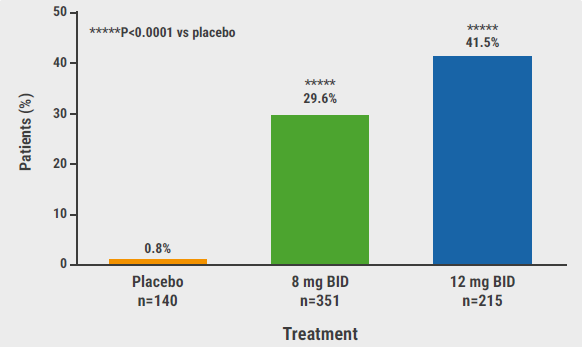https://doi.org/10.55788/2ad4836c
“Interferon is critical in LP,” Ms Angelina Hwang (Mayo Clinic College of Medicine, AZ, USA) explained in her introduction of the first-in-human phase 2 study (NCT05188521) of baricitinib in LP [1]. This knowledge of LP pathophysiology led to the rationale for the study to examine the JAK1/2 inhibitor that suppresses the production of IFN-γ. Currently, there is still a great unmet need for disease-specific medication in LP, as treatment options only include drugs like corticosteroids, topical calcineurin inhibitors, and phototherapy.
Ms Hwang presented the interim analysis of the open-label study, which included data on 12 patients with LP, 41.7% of whom had hypertrophic disease. The mean age of the participants was 63.6 years, most were women (91.7%), and all participants but 1 had failed previous treatments. Participants received 2 mg of baricitinib.
The primary endpoint of a Physician Global Assessment (PGA) response at week 16 was defined as reaching a PGA score of 0-3, with 0 standing for clear skin/ no evidence of disease, while a score of 4 or 5 was deemed nonresponsive. The primary endpoint was met by 90.9% of the participants. At this point, 45.5% presented a PGA of 0 (i.e. clear skin). Responses were observed as of week 1 in 37.5% of participants. At weeks 12 and 20, the response rate was 100%. Moreover, significant ameliorations were also found in all secondary endpoints that included pruritus, body surface area, and Skindex-16, the latter measuring the effects of skin disease on the quality of life. Out of 12 adverse events, only 1 case of neutropenia was deemed treatment-related, but not serious in severity. All other adverse events were not adjudicated to the baricitinib treatment.
These promising, initial results on baricitinib at a dose of 2 mg for LP could justify further evaluation of the agent in randomised-controlled trials.
- Hwang A. Baricitinib in the treatment of cutaneous lichen planus – interim analysis. S025, AAD 2023 Annual Meeting, 17–21 March, New Orleans, USA.
Posted on
Previous Article
« EBMT 2023 Highlights Podcast Next Article
Nemolizumab decreases lesions and itch in prurigo nodularis »
« EBMT 2023 Highlights Podcast Next Article
Nemolizumab decreases lesions and itch in prurigo nodularis »
Table of Contents: AAD 2023
Featured articles
New Developments in Dermatology
Delgocitinib shows promise as topical therapy for chronic hand eczema
Vitiligo patients maintain re-pigmentation after ruxolitinib cream withdrawal
Nemolizumab decreases lesions and itch in prurigo nodularis
Lichen planus: a future indication for baricitinib?
Atopic Dermatitis: State of the Art
As-needed ruxolitinib shows successful long-term symptom control in AD
Dupilumab: a viable option for atopic hand and foot eczema
Topical roflumilast beneficial in atopic dermatitis
IL-22 receptor blocker reduces itch and skin lesions in AD
Psoriasis: New Developments
Switching to risankizumab successful in IL-17 inhibitor non-responders
Novel, selective TYK2 inhibitor shows promise for psoriasis
Hidradenitis Suppurativa: What You Need to Know
Izokibep shows remarkably high grades of clinical response in HS
Bimekizumab could be the new up-and-comer for HS treatment
Pearls of the Posters
Biologics in psoriasis: can they prevent joint involvement?
JAK inhibitor deuruxolitinib shows encouraging hair re-growth in alopecia areata
Biomarkers predicting response of different CSU treatments in children
© 2024 Medicom Medical Publishers. All rights reserved. Terms and Conditions | Privacy Policy



